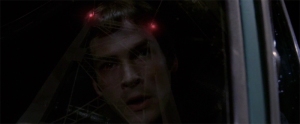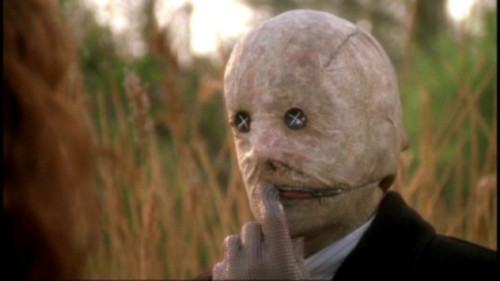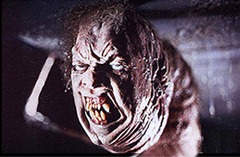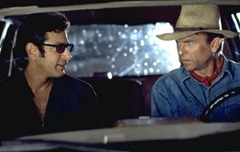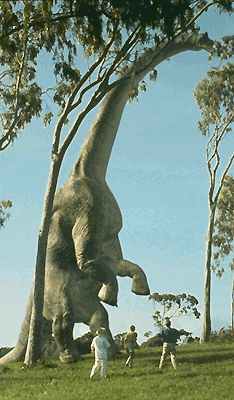by Monster Awareness Month team member: KV Taylor
In the interest of full disclosure, I should say that I was born and raised in a West Virginia-side Ohio River town. Not in Point Pleasant*–some many miles up the river–but the story of the Mothman in Point Pleasant is something we’re all pretty familiar with by early childhood, around there. Like the movie says when you fire it up, it’s based on actual events–but I’m going to try and not spoil the ending just in case you’re not a river rat.
The spin given to these actual events I mention comes from a 1975 book of the same name by John A. Keel. The Mothman Prophecies has long been a staple of cryptozoological/fortean research, though whether it’s been more useful for mocking or educating is a matter of personal taste. It’s an interesting read (once you get through the weird casual 70s misogyny and Keel’s perpetual reminding us that he’s not trying to say he’s amazing, but…), and whether it’s accurate or not, creepy as hell. Still, it’s really more of a disjointed series of interviews and strange occurrences centered around the 1967 events in Point Pleasant, interspersed with commentary on the state of ufology and paranormal studies in the 60s, than an actual narrative.
Mark Pellington’s Mothman film is a different story. We begin in Washington, DC, where John Klein (Richard Gere) loses his beloved wife Mary (Debra Messing) young. She leaves behind her drawings of a dark figure that a hospital nurse suggests is an angel, but looks a bit more sinister than that–an impression that’s helped along by the careful shot framing and impressive photography up to this point, in particular the visual theme of two glowing red circles that has been recently introduced and will continue to lead us down the path.
Also helps that said drawings are terrifying.
Fast forward two years, and Klein’s attempting to drive to Richmond in the middle of the night–and if you’ve ever driven from DC to Richmond, you won’t find that so insane, because that’s about the only time driving I-95 is tolerable. (Did I mention I now live in DC? Yeah.) Anyhow, he ends up stranded on the Smallwoods’ doorstep–unbeknownst to him a 400 mile drive from Richmond, in Point Pleasant. Cue a harried Gordon Smallwood (Will Patton) pulling a shotgun on him and backing him into the bathtub. Turns out he isn’t just being a bad stereotype–Smallwood thinks Klein has done the exact same thing several nights running, and is understandably freaked out.
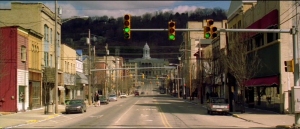
Not even sure this is Point Pleasant, to be honest, but it looks like the sort of nice town where you'd expect this sort of thing.
Officer Connie Mills (Laura Linney) shows up to save the day, and between the two of them they sort out that he’s not where he’s supposed to be, and this is yet another Weird Occurrence in a growing list in Point Pleasant. This is a lucky thing for the viewer for a few reasons. For one, only Laura Linney can deliver a terrible line like, “Things have been… strange around here” and make it come close to working. She also gets to say, when asked if she grew up on a farm, “Shucks no! … We even had shoes for church and schoolin’!” Having delivered that line myself several times, I enjoyed this particular method of dispensing with the Appalachian stereotype portion of the film.
There follows a series of disturbing events, mostly centered around Gordon Smallwood, that take on the character of disaster predictions: plane crashes and earthquakes that a mysterious being known as Indrid Cold lets him in on before they happen. In the meantime, the strange occurrences Officer Mills talked about continue all over town: strange phone calls from alien voices, sightings of the mothman here and there, causing trauma, breakdowns, and bleeding eyes. These events are taken from Keel’s book, sometimes with extreme attention to detail that makes them even more chilling when you’ve read it. But they’re all filmed in a kind of artistic horror vision that does the job well. The dialogue is drab, but again, at least the actors and crew make the best of it.
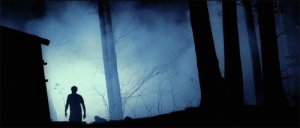
Scary otherworlder emerges from the trees to commune with his chosen West Virginian oracle, Gordon. Please don't think my flippant attitude means this didn't scare the bejeezus out of me.
Our heroes John and Connie are trying to collate all these happenings as the town, in particular the tormented Gordon Smallwood, is losing it. A discussion with the mysterious Indrid Cold, who seems to have the ability to read John’s mind and, more importantly, knows all about the death of Mary, sends John flying to Chicago to meet with a specialist in these sorts of things, a trove of fortean information called Alexander Leek (Alan Bates). He sort of fills the John Keel role, providing us with our necessary, harried neurotic paranormal investigator infodump .** Leek explains that these mothlike or birdlike creatures show up just before disasters and have done throughout human history. When Klein asks him why, we’re treated to more terrible dialogue: “Their motivations aren’t human.” And later, “You’re more advanced than a cockroach. Have you ever tried explaining yourself to one of them?”
Regardless of the lines, the man has a point both with that, and when he says they drew Klein (and, we can assume, Gordon) into this because, “You noticed them.” And most people don’t. He also deigns to offer, during a later visit, that something terrible is clearly going to happen in Point Pleasant, if mothman is showing up there.
This is where the movie starts to break down a little, pacing-wise. Klein becomes obsessed with the idea that something terrible is about to happen and that he has to stop it like he couldn’t with his wife, to the point where he’s actively screwing up everything in his life between bouncing back and forth between Point Pleasant, Chicago, and DC, and Gordon Smallwood is finally consumed by his association with the (frankly, extremely scary) Indrid Cold. Klein makes another late night drive to West Virginia from DC just in time–
For The Bad Thing to happen.
The movie has its good points and bad points. I do think the writers made a valiant effort at eking out both relevant and scary details and events from the book in their scene selection. It lacks what people in my generation would probably think of as the X-Files feeling of the book (which came long before that show, but you know what I mean), but it’s a decent way to tell the story. For some of the baffling deviations and additions, many were welcome and necessary for an effective screen adaptation: the loss of the Men In Black***, the reporter-friend Mary Hyre being transformed into the quietly bad-ass Officer Mills, and even the reworking of the Indrid Cold entity from a benevolent alien abductor into a more sinister-feeling prophet of doom.
The photography, as mentioned, is extremely effective, and perhaps the movie’s greatest strength. The use of the horror movie cheap shot with a sudden shocking image is relatively subtle and leaves an indelible impression–particularly if you watch it late at night with the lights off, as was no doubt intended. The framing and even camera pacing can feel a little overdone, but overall are extremely cool. The soundtrack is great for all the tension floating around, and the sound itself, particularly in the strange phone voices, is often shiver-inducing.
As for odd deviations, I’ve seen this movie some dozen or more times now, and I still don’t really get why they had to do the whole framing thing with Klein’s wife dying and seeing the mothman and… all of it. Well, no, I do get it: Klein, as a kind of slick, successful, but sad city fellow, is an outsider in provincial Point Pleasant, and as he becomes familiar with the town and its people, so do we–as his personal stake in discovering what this mothman is up to grows, so does ours. Except that the former seems unnecessary (I realize I’m not the best judge, but small town Ohio Valley… exactly the same as every other small town known to your average horror movie watcher) and the latter almost feels like it just serves to junk things up.
The movie doesn’t offer definite answers about the provenance and intention of the mothman–even less than Keel’s book, and in some ways, less than reality****. But I think that rather than falling flat, as leaving questions open often can, it actually adds to the mystery, uncertainty, and darkness that makes the movie worth watching in the first place. Perhaps it’s not for everyone, but odds are good that if your phone rings soon after watching it, you’ll at least consider jumping out of your skin.
*Check out that mothman statue!
**One that is not wholly accurate, as he has some weird theory that “mothman” is a translation of something this same entity is called in the Ukraine. Which is possible, of course, but Keel’s book says that “mothman” was coined by a newspaper because Batman was popular at the time.
***Don’t get me wrong, I loved the MIB in the book, but it would’ve derailed the movie.
****The Bad Thing that happens? Yeah, they know why. Also, they changed the number of people–which may simply have been out of respect for the tragic reality of the event.




